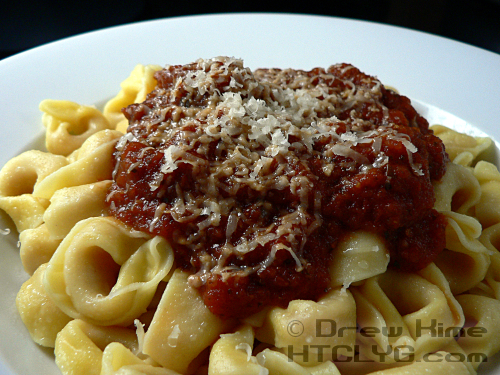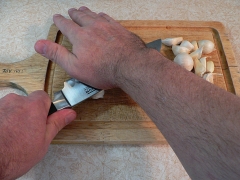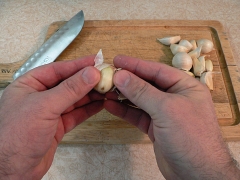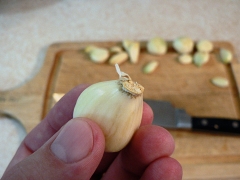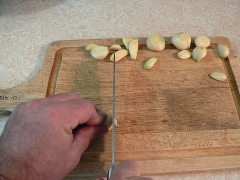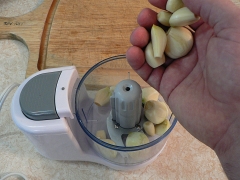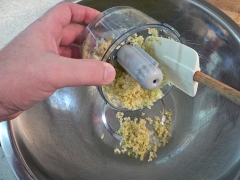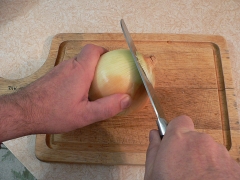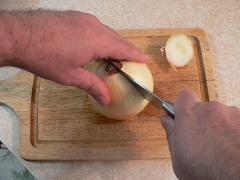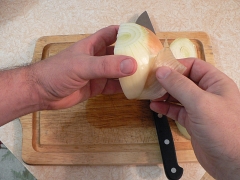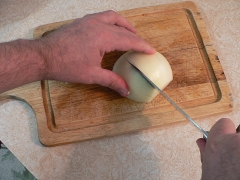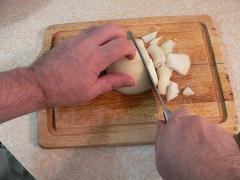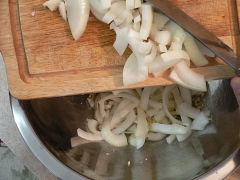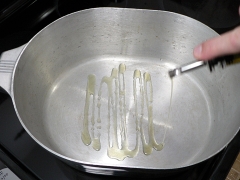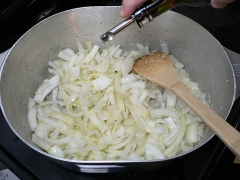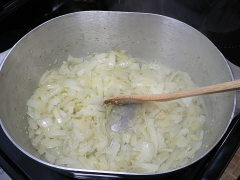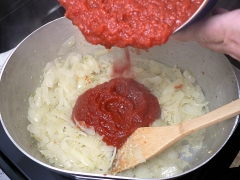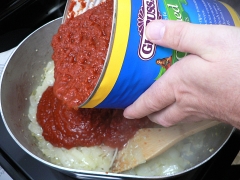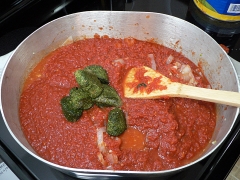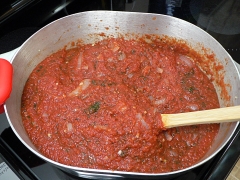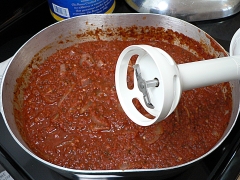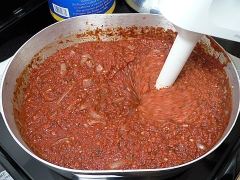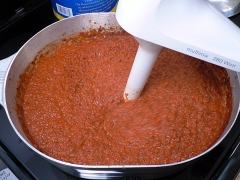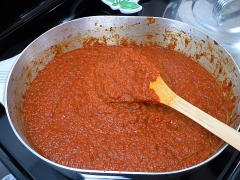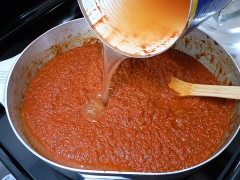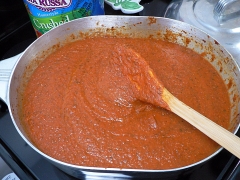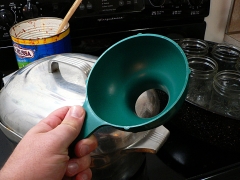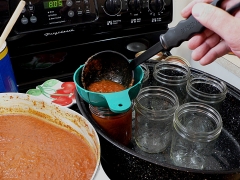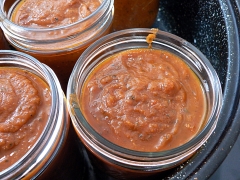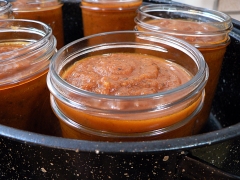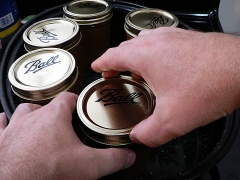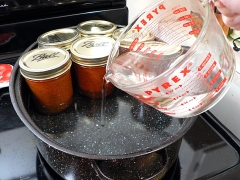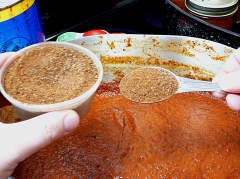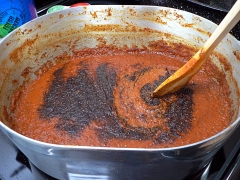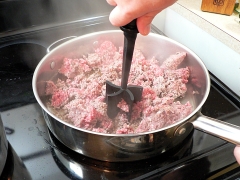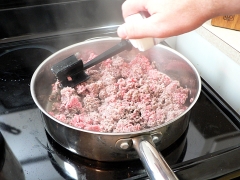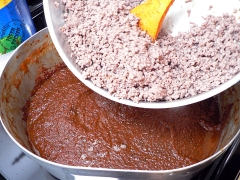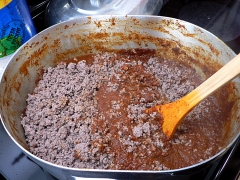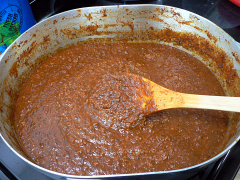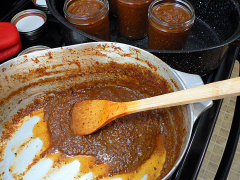I am the man. I try so hard to be modest, but I don’t know how else to put it. The texture was perfect. The wife likes it. The kids, who have never liked tomato sauce, like it. And 11 out of 12 jars sealed correctly. Here’s how I did it.
Ingredients
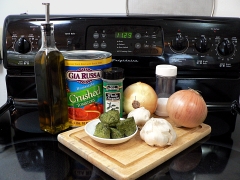
1 large huge can crushed tomatoes (110 ounces)
2 large sweet onions
10 tablespoons (2/3 cup) basil pesto
1-1/2 heads garlic
4 tablespoons dry oregano
1 tablespoon salt
1/2 – 1 cup sugar
extra virgin olive oil
2 pounds ground beef and/or sausage (not shown)
Directions
The Sauce
Don’t fear the garlic. I could easily have gone two full heads in this and been happy with it, but I wanted the girls to like it, too. After removing the cloves from the head, using the flat of your knife or the bottom of a glass lightly crush the garlic. This will loosen up the skin so you can peel it.
Each clove will have a little stem on it.
Cut that off from all of them.
When I’m doing three or four cloves, I’ll mince it by hand. For this much I used the mini-food processor. Transfer the minced garlic to a bowl large enough to hold the chopped onions.
The onions they need to be in small-enough pieces that they sauté quickly, but there’s no need to go really small. Cut the stem end off and cut in half through the root.
Peel the papery outer layer or layers off.
Slice in half or thirds lengthwise, not quite all the way to the root, then chop from stem end to root end.
Transfer to the bowl with the garlic as you finish each half.
Coat the bottom of a large pan or dutch oven with olive oil over high heat, then add the onions.
Make sure there’s enough oil to coat all the onions well, and sauté until they are translucent. Stir often enough to keep the garlic from burning.
Once the onions and garlic are cooked, add the tomatoes and salt. This is a really large can, and the dutch oven is pretty deep. If you hold the can to the side it will splash. Like this.
Oops. So lower the can right down inside the dutch oven to pour it in.
Much better. Now stir the onions and garlic up from the bottom.
Add the pesto and stir it in. (Yes I’m still using my frozen pesto from my basil crop two years ago.)
Put the lid on loosely, so that the steam can vent, and turn the heat down low.
Leave it to simmer for at least a half hour, then get your immersion blender.
Hold the blender at a slight angle so it will draw the onions in, and process the whole pot. Take care to get down into the corner of the pot all the way around.
Check the consistency. If it is too thick, add water until it seems right.
If you’re cooking for a crowd, you’re pretty much done right here. But I was making the big batch to put up for the winter. Not because I have to, just because I like my sauce better than store-bought varieties. So now it’s time for …
The canning
The only special equipment I’ve got for canning — other than the jars and lids, that is — is this funnel.
Arrange 6 one-pint jars in a roasting pan, and use the funnel to fill each jar, one by one.
Make sure you don’t get anything on the rim of the jar, or it won’t seal properly.
Just wipe up any drips with a paper towel. Make sure the rims are clean and dry.
Someone will throw a hissy fit if I don’t mention this: Sterilize your jars before using them. Okay, everybody happy? Now, off the record … tomatoes are pretty acidic. They’re not nearly as prone to going bad as, for instance, fruit preserves. So make sure they’re good and clean, but keep in mind that people used to do their canning over wood-fired stoves in kitchens with dirt floors.
Leave about a half-inch of headspace on each jar. That’s about the height of the threads for the lid. The hot air trapped in the headspace will shrink as it cools. That’s the suction that will seal the jars.
Put all the lids on finger tight. Don’t crank them on really hard, but tight enough that they don’t come loose if you bump them.
Fill the roaster with water about halfway up the jars.
Put the roaster over high heat until the water starts to boil, then reduce to a simmer and leave it for about 10-20 minutes. Remove the jars from the water and set them aside.
MAJOR IMPORTANT NOTE!
Since originally posting this, I’ve done some more research. It seems the directions I was working from were more than a little out of step with current food safety guidelines. More critically, my directions didn’t point out that meat sauce requires different handling than tomato sauce without meat.
Today’s lesson is: When you’re looking in 100-year-old cookbooks, double-check some modern sources to see if we’ve learned anything new since then. We sometimes go down the wrong path — like our completely unfounded obsession with fat — but if you’re going to disagree with modern “conventional wisdom” you should do it on purpose. Not because you didn’t know any better.
There’s a shopping trip for a pressure canner in my future.
A Second Flavor: Brown Sauce
Here’s the sauce I mentioned when I did the dehydrated pepper. The New York Spaghetti House is famous for their brown sauce. (See the FAQ for more about it.) I can’t tell you what it used to taste like before they started the current automated production methods. But my version is pretty good.
Start by adding four tablespoons of the powdered green pepper.
Brown the two pounds of ground beef and/or sausage. Crumble it as fine as you can. (That’s the Pampered Chef Mix N Chop my wife got. I’ve gotten over how embarrassingly much I like it.) If you’re doing just ground beef, salt it a little.
Add the browned meat to the sauce and stir.
Check the texture. If it’s too thick, add water like before.
Load up six more jars with the brown sauce. Process the same way as the red sauce. Read the major important note above. Use a pressure canner for meat sauce. I was so close to the exact right amount, I had just enough left over after filling the last jar to sop up with a piece of bread.
After you take the jars out of the hot water and they cool off, you should eventually hear a “pop” as the lid gets sucked down. After all the jars have come down to room temperature, press on the top of each one and make sure it’s down. If it’s not, that means you didn’t have a good seal. You can put it back in hot water and heat it until the sauce is hot all the way through. Or you can put that one jar in the fridge and have it for dinner within the next couple of days.
Yup, I had one that didn’t pop. So I put it on some tortellini.
And that’s it.
